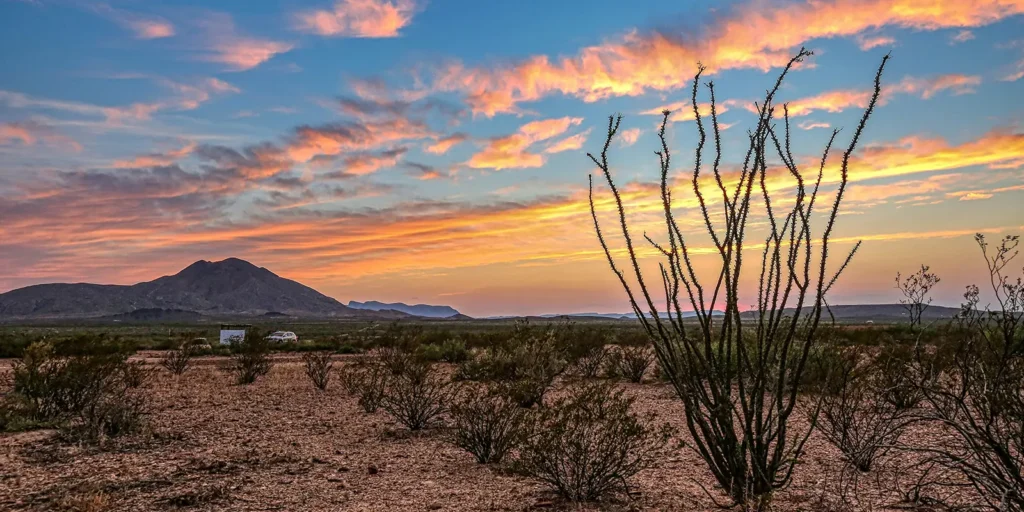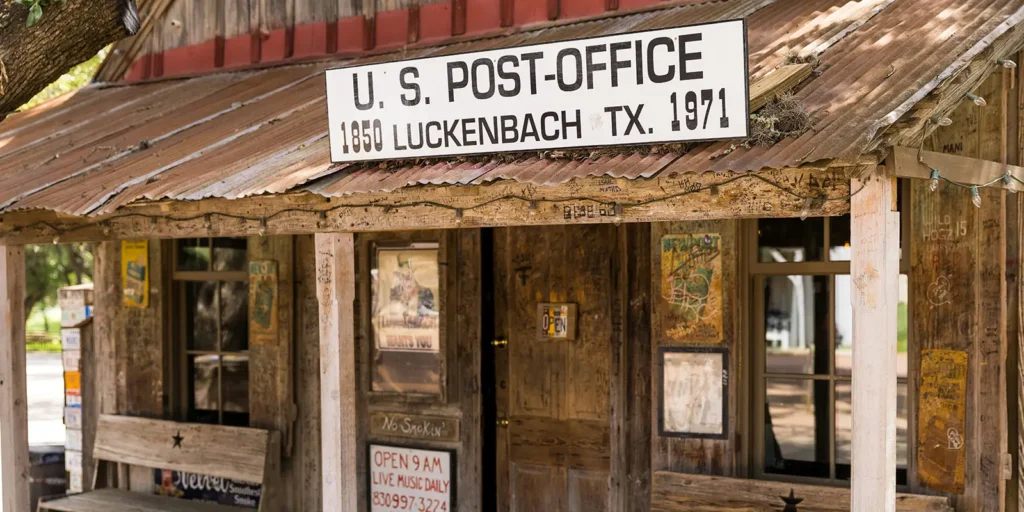Welcome to a Texan adventure through four offbeat small towns, each with its own distinct personality. From the rugged desert of Terlingua to the cowboy charm of Bandera, these destinations offer a break from the ordinary and a glimpse into the heart of Texas.
Bandera, Texas: Saddle Up for a Wild West Rodeo of Charm
Bandera hones its life at the junction of FM 16 and FM 173. FM stands for Farm to Market (roads). This tiny town of 837 calls itself “The Cowboy Capital of the World” and lies about 50 miles northwest of San Antonio. “Cowboys on Main”, sponsored by the Bandera Cattle Company, is a weekly gunfight reenactment performed almost every Saturday at the Bandera County Visitors Center.
Arthur Ventress Pue who served as a major in the 8th Texas Cavalry moved to Bandera in 1865 after the Civil War, Gambler O.C. Marsh, Scotsman George Hay, who moved to Bandera in 1854, built his home in 1870, which is part of the Convention and Visitors Center today, and Mr. Smith, possibly a saloon employee or patron, shot it out, with two ending up in their graves. You will have to go to Bandera to find out which two.
Bandera offers greenhorns the ultimate Texas cowboy experience. Check out and take your pictures in the fictional Old West town of Rattlesnake Ridge at Bandera after the gunfight. Visit and stay at several “dude” ranches in the area, where you can stay in hotels, observe working cowboys, and participate in ranch activities.
Attend regular rodeo events at the Riding the River Cowboy Fellowship church, the Riding on Faith Rodeo & Cowboy Capital Bull Bash May through July, or the Bandera Pro Rodeo. Visitors can discover why cowboys are so faithful to the words of the Bible in Bandera. Rich Texas heritage is revealed in Bandera’s investment of safeguarding its buildings and artifacts via these historic museums and attractions:
- Town Mountain Miniature Museum
- Natural History Museum
- Frontier Times Museum
- Historic Bandera County Jail
- Great Western Cattle Trail Landmark
- Bandera County Courthouse and Visitor Center

Terlingua, Texas: Desert Dreams Dancing Beneath Starlit Skies
Terlingua, an unincorporated community and not a chartered town, is best known for its annual Terlingua Chili Cookoff. Terlingua is an adaptation of the Spanish word “terlingüe”, which means three tongues. Evidence exists of the Plains Indian Tribes of Comanche and Apache inhabiting Big Bend for thousands of years before European discovery.
Álvar Núñez Cabeza de Vaca led one of the first expeditions into the Big Bend Region in the 1530s. Spanish exploration and settlement continued until Mexico won independence from Spain in 1821. Then the area attracted adventurers, traders, and ranchers when the U.S. annexed Texas in 1845.
Terlingua lies in Texas’ Canyon Country between Big Bend Ranch State Park and Big Bend National Park and is 65 miles from Mexico. star-studded night skies and vast desert basins, mountain ranges, river canyons and oases, and badlands terrain with eroded cliffs, gullies, and rock formations characterize Terlingua. Terlingua’s history gave the town a most fascinating cultural identity.
Some homes around Terlingua can be seen only by planes. Historically, Terlingua served as an isolated refuge for cowboys, wanderers, and strange characters. The closest stoplight to this town is in Mexico. Until the 1920s, Terlingua was a hub for cinnabar mining, which produced mercury. After WWII and demand for mercury declined, abandoned homes dotted its landscape.
In the late 1970s, two men set up shop as Rio Grande River guides, and placed a wooden bench at the previously abandoned Chisos Company Store. Terlingua musicians adopted that bench as “The Porch”. A flourishing venue and restaurant today, the Starlight Theatre, was a movie house, built in 1936, and then an abandoned ruin without a roof to stargaze.
A popular bumper sticker in Terlingua and Big Bend is, “Don’t Marfa My Terlingua”. Houston’s Dia Foundation fueled the modern gentrification of Marfa, Texas. You can read about that here. People live off the grid in Terlingua, and they love it that way, living in trucks, RVs, and hand built homes of grass and dirt mixed with water, and no utilities.
However, Terlingua is gaining popularity, with a steady stream of headlights on the remote roads entering it seen from a distance at night. There are teepee camps, campgrounds, a hotel and lodges, a BBQ joint and taqueria, The Porch, a general store, and the one time a year when Terlingua’s population of 127 swells to around 10,000 plus for chili.
The Terlingua Chili Cookoff hosts two annual cookoffs: The Chili Appreciation Society International and the Frank X. Tolbert/Wick Fowler World Chili Championship. The earliest grave in the Terlingua Cemetery dates to 1903, when the cinnabar mining operation began. Locals celebrate Dia de los Muertos every year, which coincides with Halloween.
Jefferson, Texas: Where History Beckons from Every Corner
Jefferson comes with a mix of bayou culture and the Antebellum South, with multiple modern trains per day blasting through blowing their whistles. It was the hub of the steamboat trade era from the Red River to New Orleans before railroads took it over. Situated on the northern edge of the Big Cypress Bayou, visitors can take a ride on the Historic Jefferson Railway, sometimes…
After the steamboat trade died out, rail was the way to haul cotton from Texas to the port in New Orleans. The Historic Jefferson Railway has gone through a long, long, long battle to preserve itself, mainly due to the expense of maintenance, replacing historic engine parts, machinery, and tracks. Nearly 90% of the rail trip follows the Big Cypress Bayou.
You can check its Facebook page for trip times to see the slow running bayou, where thousands of bald cypress, dogwood, Magnolia, maple, oak, pine, redbud, and sweet gum trees line its tracks, plus a bounty of Piney Woods wildlife. Jefferson delivers much more than an old railway with history alive in every corner.
The Antebellum Jefferson is the Bed & Breakfast Capital of Texas, with dozens of B&Bs to choose from. Charm and elegance rules in the Jefferson Historic District. This southeastern part of central Jefferson takes you to an era of prosperity when ladies donned parasols and fluffy petticoats in the horse-drawn carriages.
The National Register of Historic Places added 107 acres in Jefferson to its program in 1971, and is administered by Texas Historical Commission in coordination with the National Park Service. Nineteenth century Old South grace and romance comes alive from the “Golden Era” in this district with so many homes and buildings to explore. Visitors can take horse-drawn carriage tours on most weekends.
To top that off, a classic general store, quaint boutiques, restaurants serving classic southern style eats, Mexican fare, BBQ, brunch destinations, and modern cuisine, along with a nightlife scene adorning the streets of Jefferson. For the perfect girl’s getaway or couple’s romantic retreat, Jefferson, Texas, is the place to be.

Luckenbach, Texas: Every Day is a Song and Dance
We do not know of any native Texan who was not introduced to Luckenbach during Willie Nelson’s comeuppance in 1977 with the release of Luckenbach, Texas: Back to the Basics of Love, but we’re old. The tiny unincorporated community of Luckenbach sits in the German region of the Hill Country. The Engel and Luckenbach families established this community circa 1840.
Luckenbach is a Texas country music hub thanks to local legend, John “Hondo” Crouch. The entire town of Luckenbach went on the real estate market in the 1970s, and no one in Luckenbach wanted outsiders to buy it. Hondo wanted to see musical magic happen, so he and his partners bought Luckenbach. Luckenbach’s legendary dance hall proves it.
The Luckenbach Texas General Store, Bar & Dancehall has continually operated since 1849. Perched on the banks of South Grape Creek and a suburb of sorts southeast of Fredericksburg, is Luckenbach. Visitors can spend two weeks in this area and never see all it has to see. Germans began immigrating to Texas as far back as the War of 1812, and their Old Country culture is truly alive today.
Luckenbach’s commercial operations carry names like Auslander, Biderman’s, Hoffman Haus, and Marketplatz. Locals speak German, English, and Spanish equally. Visitors can relish in the town’s motto, “Everybody is Somebody in Luckenbach.” If you love German cuisine, the restaurants there serve up too-die-for fare.
At the Luckenbach Texas General Store, Bar & Dancehall, you can listen to the music of top Texas musicians and bands and tales from Texas story tellers. Although we lost Rusty Weir in 2009, Jerry Jeff Walker still graces its stage. Writer John Steinbeck immortalized Luckenbach as “A Texas State of Mind”. Luckenbach truly is that and will take you back to a simpler Texas time that does not exist in so many places these days.